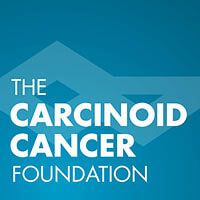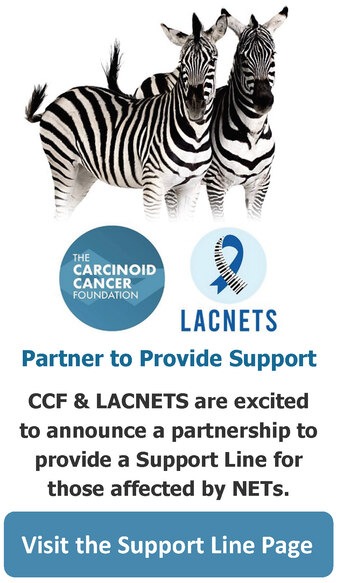The Hero’s Journey is a narrative template identified by writer Joseph Campbell. It is said to be the greatest story ever told because it has appeared over and over in some of our most beloved stories and movies such as Jaws, Star Wars, and my personal favorite, Thelma and Louise. It is an overwhelming obstacle assigned to an un-wanting individual who must find the strength to endure and persevere.
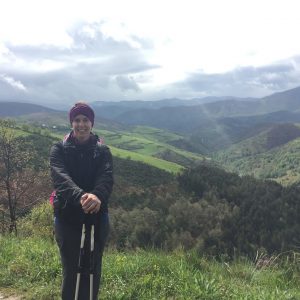
Stacie on the trail!
It is my story and the story of many cancer survivors.
Every hero’s journey begins in The Ordinary World. For me, Step 1, The Ordinary World included ordinary things such as gorgeous husband, a nice home and, eventually, a couple of kids. Nothing filled me with more joy than traveling, writing and being outdoors, but these were hobbies and not career paths.
Step 2, The Call to Adventure. My Call came in the form of a VIPoma, pancreatic neuroendocrine tumor. Unlike most NET cancer survivors, I was lucky to be diagnosed within a month from the onset of symptoms. After the doctors calmed down from the “excitement” of a rare diagnosis, a plan was developed. I was told, the cure was surgery and I would not need any additional treatment.
Step 3, The Refusal of the Call. So, I had surgery. A distal pancreatectomy and splenectomy. Being young (34) and in good shape, I recovered fast and even though it didn’t seem to fit anymore, I went back to my corporate job. This was my refusal of the call. Also, I continuously questioned my doctors, “Are you sure I don’t need to be on any medication?” and “Is there any additional testing we should be doing?” I began researching and connecting with other pNET patients through an online support group on Inspire.com. It was there I learned about Octreoscans and requested one for my first post-surgery follow-up. Good thing I did, because several spots were found in my liver, but doctors held their ground telling me to “watch and wait.”
Step 4, The Meeting with the Mentor. My instincts kicked in and I decided I couldn’t sit back and let these cells multiply without exhausting every measure within my control. The Inspire community encouraged me to run to a specialist. Plus, slowly, but surely some alarming symptoms resurfaced – flushing, racing heart and terrible digestion. I remembered watching a YouTube video on The ABCs of Carcinoid and really liking Dr. Edward Wolin. He seemed nice, knowledgeable and positive. I looked him up on the Carcinoid Cancer Foundation’s list of specialists and discovered he recently transferred to the University of Kentucky, which was only a few hours away from where I live in Nashville. Within minutes I picked up the phone and started the process to get an appointment. When he and I finally met, it felt good when he told me that not only did he have patients like me, but he immediately knew what to do. Finally, a plan! Dr. Wolin even re-reviewed my pathology slides to reveal my case was even more complicated due to the unusual mix of cell differentiation, mitotic rate and Ki67.
Step 5, Crossing the Threshold. This is where the hero commits to leaving the Ordinary World. This all sounds so voluntary, but I was pretty much kicked into the threshold. I left my job and was told I needed to start CAPTEM, oral chemotherapy…on the same day.
Step 6, Tests, Allies and Enemies. I began CAPTEM, however, after a couple months, I became sicker. I hoped it was side effects from the medicine, but when I went for a check-up, I found out the disease had progressed again.
Step 7, The Approach, where the hero and allies prepare for a major challenge, which meant intravenous chemotherapy. Dr. Wolin ordered a cocktail of Carboplatin Etoposide.
Step 8, The Ordeal, where the hero confronts their greatest fear. I was scared of chemotherapy, but you know how you can tell you’re really sick? When you feel better on chemotherapy. Eventually my symptoms lessened and three months later an MRI revealed the cancer had finally responded to treatment. While Dr. Wolin wanted me to do three more rounds of Carboplatin Etoposide, I talked him into surgery with a promise to finish chemo as soon as I recovered. He referred me to a wonderful surgeon, Dr. Roberto Gedaly, who agreed to see me the same day to get the ball rolling.
Step 9, The Reward. Who would have ever thought a liver resection would be a reward? It was for me. Again, want to know how you’re really sick? When you wake up feeling better from a surgery where they literally cut you in half. The best news of all, when I woke up, my husband and Dr. Gedaly told me it appeared as though they got all the cancer.
Step 10, The Road Back. Five weeks after I had surgery, I resumed Carboplatin Etoposide and completed my last treatment on Christmas Day. Weeks later, a new round of exams and an MRI confirmed there was no evidence of disease in my body.
Step 11, The Resurrection, where the hero re-enters the Ordinary World and the conflict is resolved. With check-ups every few months and monthly Lanreotide injections, I can’t quite say I’m resolved, but with two clear scans under my belt, I’m pretty excited. More than anything, I am grateful to be here and feeling good.
It took cancer to make me realize I was not living my authentic self. I was not meant to spend my time here on earth in a cubicle, stressing out over work I don’t love. Now, I know this and I’ve got big plans. Remember my love of traveling, writing and the outdoors?
I have been writing nearly everyday since the beginning of the year. I even picked up a freelance writing job with Cure Magazine, where I share my experiences and cancer wisdom.
Also, since I was diagnosed, I’ve been dreaming of a traveling again. In March, my husband and I went on a romantic beach vacation. We banished any talk of cancer during the week and it was glorious. (Read about that here)
Also on the horizon – yoga teacher training, finally writing that book that’s been in my head for years and a week of surfing in California with First Descendants, an organization that takes young adult cancer survivors on adventure trips.
However, what I was most excited for was fulfilling my dream of finishing the El Camino de Santiago (or simply known as, the Camino). In 2012, I completed half of this 500 mile pilgrimage across Spain that people have been walking for centuries. The journey begins in a little village in France and ends at a cathedral in the western city of Santiago de Compostela. While the origins of the walk are religious, people do it now a days for all kinds of reasons and purposes. My reason and purpose – break free from the confinement cancer created. For years I’ve been wanting to go back to complete the journey, but some project or the lack of time always seemed to get in the way.
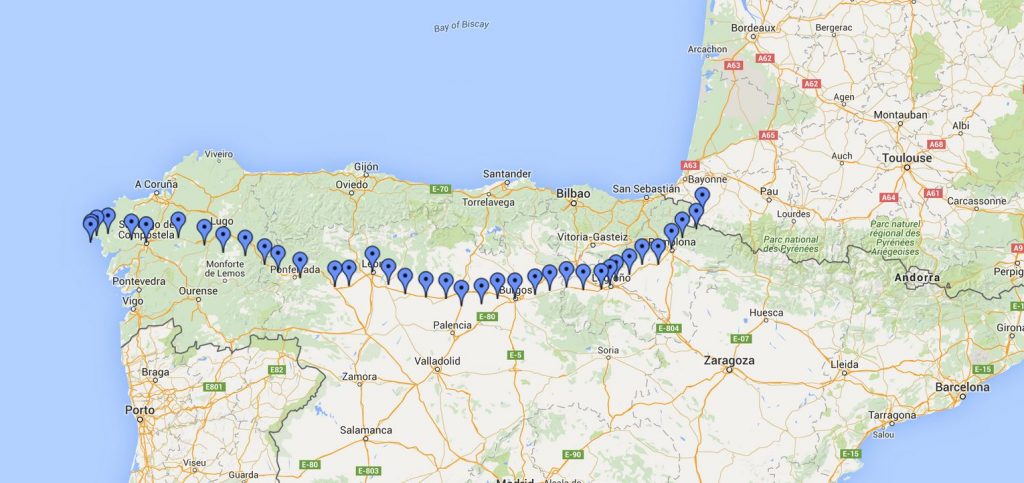
The last step in the hero’s journey is where the hero Returns with the Elixir. Here, “the hero returns home or continues the journey, bearing the power to transform the world as the hero has been transformed.”
If cancer teaches us anything, it’s that tomorrow is not guaranteed and if you want to do something, there’s no better time than right now. So, as soon as I felt well and strong enough, I bought my plane ticket and started accumulating hiking equipment.
Before I knew it, I found myself in Leon, Spain where I re-started the Camino on May 18th, 2016. 15 days later, I found myself staring at the Cathedral of Santiago. I still have not found the words to describe the feeling.

However, I decided I couldn’t stop there. As a writer in love with symbolism, I had to continue on to Finesterre, the place once thought to be the end of the world. After 19 consecutive days of walking 258 miles, I concluded my Camino in Finesterre, at the Atlantic Ocean, on June 5th, National Cancer Survivor’s Day.
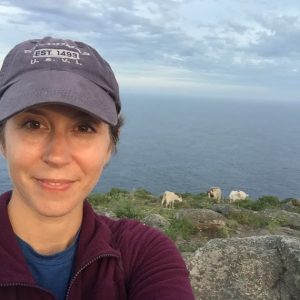
Stacie in Finesterre, the end of the world, on National Cancer Survivors Day
When pilgrims arrive in Santiago, they are rewarded with a certificate of completion, called a compostela. One of the questions they ask is where you began your journey. Some people say the city where they were born. Some say the little village in France where they started. Some say where they live now. However, it only made sense that my answer was, where every hero’s journey begins – The Ordinary World.
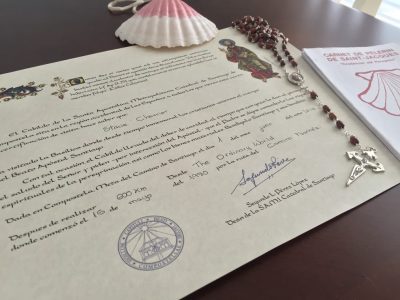
The compostela awarded to Stacie upon the completion of her journey
To learn more about the El Camino de Santiago, visit http://www.americanpilgrims.org
To read more about Stacie Chevrier’s journey in Spain, visit www.staciechevrier.com or follow her on Twitter @staciechevrier
